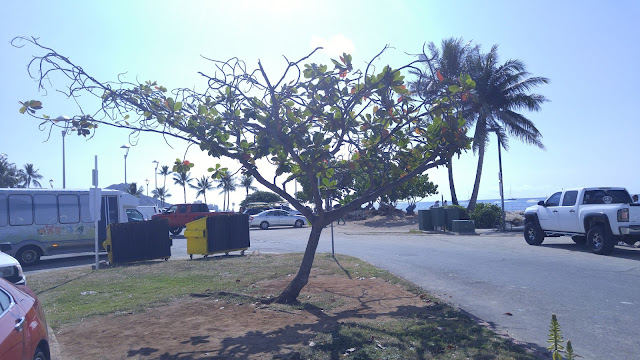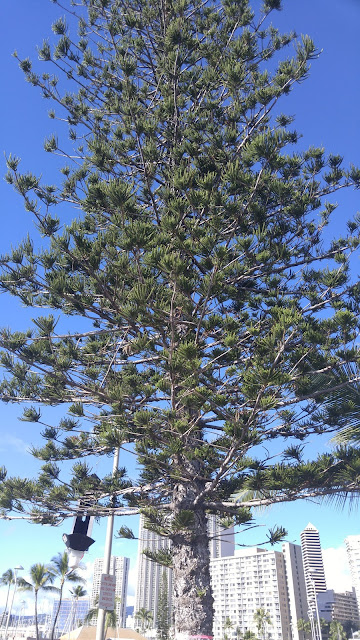So what's living in a highly developed place like this? Well, many of the plants appear to be placed here on purpose by the landscapers who developed the property. Single trees or shrubs are evenly spaced in the parking lot. Close to the beach there is a small space where several plants are sharing the same lot. I can't speak on whether this was intentional or natural. Waikiki is also on the leeward side of the island, so the climate is relatively dry. This is a limiting factor for plants without intensive watering by people. Refer to my first post for a list of the guides I will use for identification. I will also be using the UH Manoa campus plants guide provided by the UH Botany department to identify some of the introduced species found at this location.
The Aloe (Aloe vera) is a striking plant that is popular due to its medicinal properties and popularity in consumer products like drinks, lotion, or sunburn relief. The flowers are raised on stalks and are yellow-green in color.
False Kamani (Terminalia catappa) is a common sight around the island of O'ahu. This particular tree doesn't seem to be doing too well, but in general the plant thrives here. The tree is wide-spreading and short. These trees are generally used for timber on the island.
I couldn't find an ID for the next 5 plants with the guides I have. They look like plants that I have seen on the mainland of the US, but I don't know their common names with confidence. The grass is a common grass used for turf but it isn't well maintained out in this part of the lot. While I don't know what these plants are specifically, I am pretty confident that they are not native and were planted here for show. This is another reason I did not tackle the flora of the Hilton hotel itself as their feature here simply claims that there are over 50 species from all over the world planted in the gardens and around the property.
Out of all of these introduced plants, I believe the below is the Monkeypod (Samanea saman). The plant is characterized by the long, thin pods of leaves. The flowers are pink when they are in bloom, but they are not visible here. It is commonly used for ornamentation, such as it is here.
Down on the beach itself there are more false kamani trees and some coconut palms (cocos nucifera) that are also very common around developed areas as well as coastal areas. Coconut trees are considered the tropical plant and often associated with Hawai'i by visitors (such as myself), but the plant is not native. In fact, coconuts were introduced by early Polynesian explorers in canoes.
The Grand Crinum (Crinum asiaticum) is a medicinal plant from Asia. The plant is characterized by its white flowers and wide leaves.This plant is known as Milo (Thespesia populnea). It is not known whether the plant is non-native or indigenous, but it would have been an early Polynesian introduction. It has drooping, heart-shaped leaves. The flowers on this plant are yellowish-pink with a red center.
The 'Akoko (Euphorbia skottsbergii) is a Hawaiian endemic plant. This variety is found only on O'ahu in coastal areas.
I got a glimpse of the Hilton property here and I spotted a bunch of very green naupaka (Scaevola taccada). These coastal plants are native to Hawai'i and it was nice to see them among the non-natives. Another difference here from Kaena is that the plants don't have yellowed leaves. The groundskeepers here keep everything lush and green.
Summary:
Rating: 3/5
This part of Waikiki was very nice, but full of non-natives. Here I should define non-native; an organism that was introduced to an area by humans. This is slightly different from an invasive species, which is an organism that threatens native organisms. The area contains mostly non-native plants that have been specifically placed there. This makes the beach look more tropical. However, this doesn't give native flora a chance to shine. There are very few native species here as compared to Ka'ena.
The small beach is mostly used by surfers so there aren't many people who go there to sunbathe. This would be a good spot to go for surfing and hanging out at the beach if you just want to get in the water or sit under some shade. I enjoyed my time at Ka'ena more, but I also enjoyed getting the chance to go in the water here.
Web Citations:
"Hilton Hawaiian Village Oahu." Oahuvacationguide.com. Oahuvacationguide.com, n.d. Web. 24 Feb. 2016.
"University of Hawaii Campus Plants, UH Botany." University of Hawaii Campus Plants, UH Botany. Gerald D. Carr, 29 Mar. 2006. Web. 24 Feb. 2016.
















No comments:
Post a Comment